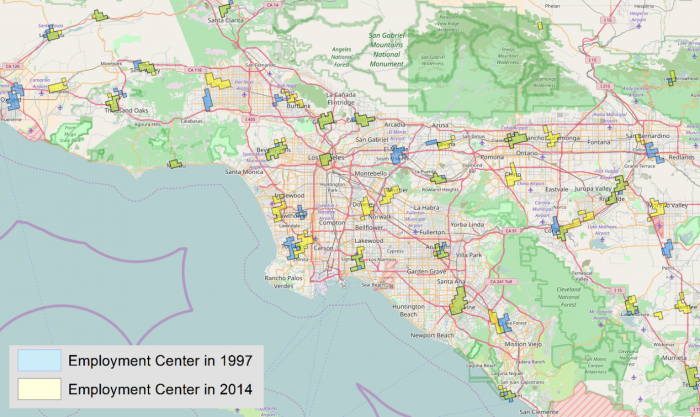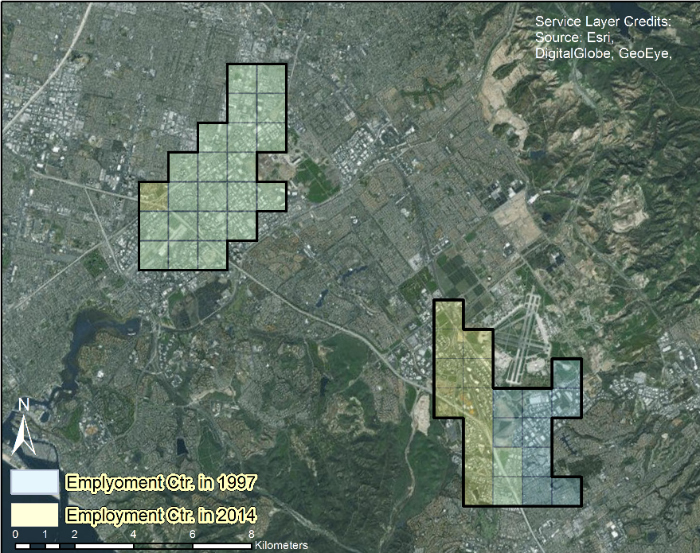 Just as cities are places where people live, they are also places where they work. But does where people work in cities remain stable over time? In new research focusing on Los Angeles, Kevin Kane and the UC-Irvine Metropolitan Futures Initiative look at changes in where jobs are located between 1997 and 2014. They find that over the study period, employment centers emerged, grew, contracted and died far more often than expected, meaning that their location did not remain constant. He also finds that emerging centers of employment were more likely to be found close to transport infrastructure and Los Angeles’ downtown.
Just as cities are places where people live, they are also places where they work. But does where people work in cities remain stable over time? In new research focusing on Los Angeles, Kevin Kane and the UC-Irvine Metropolitan Futures Initiative look at changes in where jobs are located between 1997 and 2014. They find that over the study period, employment centers emerged, grew, contracted and died far more often than expected, meaning that their location did not remain constant. He also finds that emerging centers of employment were more likely to be found close to transport infrastructure and Los Angeles’ downtown.
The Los Angeles, California metropolitan region is one of the United States’ largest economic engines. Employing roughly ten million people and home to nearly twice that amount, Southern California is as synonymous with sunshine as it is with traffic congestion.
The Los Angeles area has been a favorite object of study for geographers, urban planners, and other urbanists exploring the so-called “polycentric metropolis.” A polycentric urban area is one that is no longer defined by a single downtown or city center but instead has developed multiple centers of economic activity. While residential suburbanization has been a major feature of American cities since at least the Second World War, a “polycentric” metropolis is distinctive in that businesses have followed people to the suburbs and begun to form distinct clusters outside of the traditional central business district.
Since the early 1990s, academic research has tried to identify and define these centers of activity. However, the study of polycentricity and employment centers largely remains rooted in 20th century theory making use of 20th century data. Ideas about polycentricity and edge cities (popularized by books like Edge City by Joel Garreau) largely flow from late-20th century concepts about the transition to a post-industrial service economy, the “death of Geography” that will be brought about by globalization and computerization, and the impact of perpetually decreasing transportation costs. Empirical studies of 20th century employment concentration generally highlight how centers are persistent over time, emphasizing longstanding ideas about the path dependence of economic landscapes. Most employment centers are heavily conditioned by the location of prior hubs of economic activity, particularly around L.A.
A number of recent urban changes might impact these trends. Advocates of New Urbanism and Smart Growth emphasize how growth should be directed toward areas with existing infrastructure and already high activity concentration, rather than new areas, to increase an area’s “sense of place” and reduce transportation needs. Proponents of urban sustainability echo these sentiments, citing concerns over carbon emissions, local pollution, and local climate impacts such as the urban heat island. Regional economists also stress how successful, global cities are attractive to so-called “creative class” workers who are drawn toward urban amenities.
In our research, we adapted state-of-the-art geographic statistical methods for identifying employment centers in Southern California between 1997 and 2014. The difference from previous research is that we use commercially-provided business establishment data rather than aggregated official statistics such as the Census Bureau or Bureau of Labor Statistics. In this way, the precise location of employment is known allowing us to aggregate businesses to 1km x 1km grid cells across the region rather than census tracts. The scale of the analysis can be both finer and atheoretical since census tracts are drawn around residential – not business – populations. A locally-weighted regression technique is used to identify centers and their boundaries based on expected employment density. An immediate difference is that the boundaries of centers (shown in Figure 1) change substantially since they are no longer beholden to census-drawn borders. Some key insights emerge:
- Areas with high employment density are comparatively small and cover only about 3 percent of the urbanized area
- Centers represent a fairly small proportion of total employment, though this share grew from 17.4 percent in 1997 to 19.6 percent in 2014
- Growth in centers outpaced overall employment growth in this period 45.4 percent versus 29.3 percent, though not every center performed equally well
- Despite this, more new jobs were created outside of centers (1.3 million) versus within centers (about 500,000).
Figure 1 – Employment centers in Southern California, 1997-2014

Looking more closely at the boundaries of centers:
- Employment centers emerged, died, grew, and contracted more than expected.
- While the land area of employment centers increased from 445km2 to 530km2, only 294km2 was common to both periods.
- Only 5 centers had the same boundaries in 1997 and 2014: downtown Los Angeles, Glendale, Montclair, Malibu, and Blythe
- Three centers had less than 10 percent of their land area in common between 1997 and 2014: Torrance, Covina, and Irvine/Lake Forest.
Two Orange County centers (Figure 2) illustrate the type of “boundary change” that is characteristic of many of the region’s centers. The northern center, extending from Orange County airport north to include parts of Irvine, Santa Ana, Costa Mesa, and Tustin, is widely known as a location of businesses and headquarters. 95 percent of its land area persisted as a center between 1997 and 2014.
Figure 2 – Changing employment center boundaries in Orange County

The center further south has seen a major change in composition. In 1997, the local peak of activity was a light industrial area surrounding a pair of major arterial roads adjacent to a recently shuddered Marine Air Corps Station. However, substantial development in the region – including a major shopping mall (the Irvine Spectrum Center) shifted the concentration of local employment eastward. Only two square kilometers of dense employment connect these two regions – principally those near a freeway interchange.
Other centers show similar processes of directional shifting. Some, including those in the San Fernando Valley and Burbank – are not even contiguous between 1997 and 2014, in the latter case shifting from an area of strip retail toward Burbank’s commercial airport and historic downtown core (see Figure 3). The center in Torrance has only 2km2 in common between its 1997 and 2014 variants. Whereas in 1997 employment in Torrance was concentrated farther east along a major arterial road, employment density has crept farther east toward the junction of the I-405 and Rte. 110 freeways.
Figure 3 – Changing employment center boundaries in Los Angeles County

An interactive web mapping application displaying all centers can be found here. These changes are also summarized in a short video.
We also analyzed these changes empirically, labeling each 1km2 grid cell as “persisting” if it is part of a center in both years, “vanishing” if it was part of a center in 1997 but not in 2014, and “emerging” if it newly became part of a center in 2014. Some clear (and statistically significant) trends emerge:
- Emerging cells are about 20km closer to Los Angeles’ downtown, on average, than either persisting or dying cells
- Emerging cells are significantly closer to freeways, airports, rail lines, and the Pacific coast
These trends suggest that employers in new areas appear to be more selective in their location choices: growth in job concentration is systematically closer to amenities and fixed infrastructure like transportation. Identifying centers also allowed us to analyze trends in five key industries: knowledge-intensive business services (KIBS), retail, creative class employment, high-tech, and industrial employment:
- While KIBS are more likely to exist in employment centers than overall, their propensity for concentration decreases
- High-tech employment shows a much increased propensity to concentrate by 2014
- Unexpectedly, industrial jobs are increasingly concentrated in centers despite a 23 percent decline overall
- While retail jobs exist fairly evenly throughout the region, nearly half of the region’s centers are more specialized in retail employment than anything else, particularly in more outlying areas along freeway corridors. Even though these are typically lower-skill, lower-paying jobs, they are a major driver of regional employment concentration.
This article is based on the paper, ‘Los Angeles employment concentration in the 21st century’ in Urban Studies. A more complete treatment of these results can also be found found in the UCI Metropolitan Futures Initiative’s report, ‘Jobs-Housing Balance in Egohoods in Southern California’.
Featured image credit: Ricardo Araujo (Flickr, CC-BY-NC-2.0)
Please read our comments policy before commenting.
Note: This article gives the views of the author, and not the position of USAPP – American Politics and Policy, nor the London School of Economics.
Shortened URL for this post: http://bit.ly/2lnC7Ek
_________________________________
 Kevin Kane – University of California-Irvine
Kevin Kane – University of California-Irvine
Kevin Kane, PhD is a postdoctoral research fellow in the Metropolitan Futures Initiative at the University of California, Irvine. He is an economic geographer interested in the quantitative spatial analysis of urban land-use change and urban development patterns, municipal governance, institutions, and economic development. His research uses land change as an outcome measure – in the form of changes to the built environment, shifting patterns of employment, or the socioeconomic composition of places – and links these to drivers of change including policy, structural economic shifts, or preferences for how we use and travel across urban space.
The Metropolitan Futures Initiative in the School of Social Ecology at the University of California, Irvine aims to develop an improved understanding of communities and their potential for integrative and collaborative planning and action to ensure a bright future for the region. It approaches these goals by bringing together an interdisciplinary research team along with the insights and techniques of “big data” research.







1 Comments